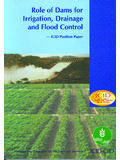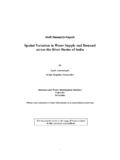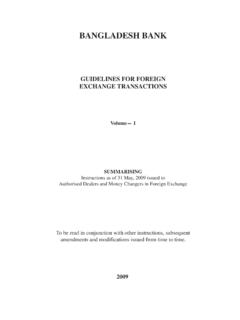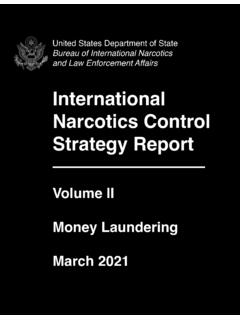Transcription of Aquatic Weeds & their Management - Irrigation
1 Aquatic Weeds & their ManagementReviewers:Mrs. Lidia Lancar (France)Mr. Kevin Krake (Australia)International Commission on Irrigation and DrainageMarch 2002iiAQUATIC Weeds & THEIRMANAGEMENTCONTENTSI. Global Irrigated Damages caused by Aquatic Classification of Aquatic Emergent Floating Submerged weedsII. GLOBAL SCENARIO OF WEED FLORA IN SOME South and South-East Australia and New North and South PROBLEMS RELATED TO Aquatic Emergent Floating Submerged Effect of Aquatic Weeds on environmentV. Management OF Aquatic Preventive Control Physical or mechanical control Ecophysiological Biological control of Chemical methods of weed Commonly used herbicides for weed controlBIBLIOGRAPHYiiiLIST OF BOXESBoxTitlePage Effects of Weeds22 Major Aquatic Weeds of the world103 Important Weeds of the Aquatic environment of India134 Bioagents introduced in India for biological suppression of Aquatic Weeds (Singh,1989)
2 36ivLIST OF TABLEST ableTitlePage distribution of area under arable and permanent crops, andIrrigated Area12 Distribution of Aquatic Weeds in different regions of the world103KG Herbicide gravity feeder discharge of magnitude H, area and diameter of theorifice at different heads45vLIST OF FIGURES/PHOTOGRAPHSF igure/PhotographTitlePage Water hyacinth (Eichhornia crassipes), a free floating weed52. Water hyacinth (Eichhornia crassipes) infestation in Irrigation canal53. Vallisneria, a submerged Aquatic weed64. Hydrilla verticillata, a submerged Aquatic weed75. Infestation of Typha latifolia, an emersed weed76. Najas, a submerged Aquatic weed87. Dredging essentially meant for desilting along shores also helps inremoval of Aquatic weed vegetation248.
3 Lining of canals helps in reducing weed vegetation (Yamuna CanalHaryana, India)259. High velocity of water in flow water system discourages weed growth2610. Infestation of Algae and submerged Aquatic Weeds in Baigul Dam ( ),India2611. Collection of water hyacinth in flow water system2712. Clean water encourages growth of submerged weed vegetation inponds, tanks and reservoirs2813. Covering the water surface with Azolla helps to check under water weedvegetation2914. Movement of turbid water reduces the growth of submerged aquaticweeds2915. Infestation of Typha latifolia on the banks of large pond in Avanti BaiSagar Project ( ), India3016. Earthern bank large reservoirs having shallow depth near banksencourages the growth of submerged Aquatic vegetation3117.
4 Large scale infestation of Ipomea carnea in water tanks in Maharashtra,India3118. Large scale infestation of water hyacinth (Eichhornia crassipes) indrainage system in Haryana, India3219. Grass carp (Ctenopharyngodon idella), voracious feeder of submergedaquatic weeds3420. Visible impact of Neochetina infestation on water hyacinth in a water tank3721. Cytrobagous salviniae feeding on Salvinia molesta3722. Neochetina eichhorneae feeding on the leaf of water hyacinth3823. Neochetina bruchi feeding on the growing ponds of water hyacinth3824. Conductance of water through underground conveying system watersource to tank saves from problem of Aquatic Weeds (Maharashtra StateElectricity Board, Nagpur, India)3925.
5 Special spraying arrangement for sites unmanageable from the banks26. KG Herbicide gravity feeder27. Influence of Glyphosate kg/ha. on lpomea carnea (Effect visibleafter 10 days)4728. Influence of Glyphosate @ kg/ha. on lpomea carnea (Effect visibleafter 20 days) Irrigated Areaf the world's total geographical land area of 13045 mha, mha of arable land area is underpermanent crops, sustaining a population of 6 billion people. The world s total irrigated area m ha in 1997 (FAO 2000) which is total arable land. It is this land which providessustained and assured productivity of crops and employs high input returns. The continentwise spread ofirrigated area indicates that Asia has the maximum irrigated area followed by Europe and Africa.
6 (Table1).Table 1. Continentwise distribution of area under arable and permanent crops, and Irrigated AreaContinentArea under arable &Permanent crops (APC)(m ha)Irrigated area(m ha)Percentage ofirrigated land : FAO yearbook Vol. 49, the African continent, there is wide variability amongst countries as regard the percentage areairrigated to total arable area. For Egypt has 100%, Sudan 15%, Morocco and South of the total arable land under North-Central America, has the maximum arable area but irrigated area constitutes only the area and Mexico has arable area under the South American Continent, Peru has 41% area under Irrigation followed by Chile ( ),Argentina ( ), and Brazil (6%).
7 The Asian continent has of area under Irrigation of which Pakistan has followed by SouthKorean Rep. ( ), Japan ( ), China ( ), Iraq ( ), Iran (40%), and India ( ).In Europe, Romania has of arable land under Irrigation followed by Italy (25%), Bulgaria ( ) andSpain ( ). In Oceania, Australia has of the total arable area under year, efforts are being made to increase the area under Irrigation with the sole purpose ofincreasing productivity of the land. The area under Irrigation and corresponding water availability hasincreased globally over the past 20 years with the building of storages, tanks and channels for irrigationand fish Damages caused by Aquatic weedsAquatic Weeds are those unabated plants which grow and complete their life cycle in water and causeharm to Aquatic environment directly and to related eco-environment relatively.
8 Water is one of mostimportant natural resource and in fact basis of all life forms on this planet. Therefore, appropriateO2management of water from source to its utilization is necessary to sustain the normal function of life. It isone important part of natural resource Management . The presence of excessive Aquatic vegetationinfluences the Management of water in natural waterways, man made canals and reservoirs whichamounts to millions of kilometres/ square kilometers of such water bodies around the world. The areaunder small tanks and ponds is equally important due to the establishment of many small irrigationschemes and watershed Management projects all over the world.
9 For example, India has m ha underwater in reservoirs and m ha under Irrigation canals. The area under village ponds and tanks isnearly m Weeds often reduce the effectiveness of water bodies for fish production. Aquatic Weeds canassimilate large quantities of nutrients from the water reducing their availability for planktonic algae. Theymay also cause reduction in oxygen levels and present gaseous exchange with water resulting in adversefish production. Although excessive weed growth may provide protective cover in water for small fishgrowth it may also interfere with fish growth of Aquatic Weeds may provide ideal habitat for the development of mosquitoes causingmalaria, encephality filarasis.
10 These Weeds may also serve as vectors for disease causing organismsand can greatly reduce the aesthetic value of water bodies from a recreational point of Weeds have been found to severely reduce the flow capacity of Irrigation canals thereby reducingthe availability of water to the farmers field. Aquatic Weeds may also damage pumps and turbines insuper thermal power stations and hydroelectric power stations influencing electric production andincreasing the cost of maintenance of power stations. Many Aquatic plants are desirable since they mayplay temporarily a beneficial role in reducing agricultural, domestic and industrial pollution.










